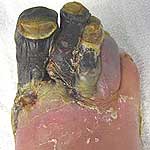Gangrene is localized soft-tissue death (necrosis) from prolonged blood-supply blockage. It can occur in atherosclerosis, diabetes mellitus, or decubitus ulcer, and after severe burns or frostbite.
New research studies are finding different new ways to treat gangrene to save body parts.
Gangrene is a dreadful disease in which the profession has failed to offer much in the way of relief for these patients.
